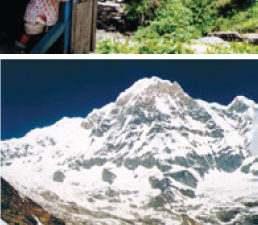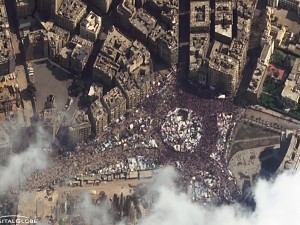
- Ray A. Williamson, PhD
Senior Advisor
Secure World Foundation
Broomfield, Colo.
www.swfound.org
Indeed, in November 2013, MCTP hosted a high-level bilingual practicum focused on the use of space science and technology for the prevention of and response to disasters in Mesoamerica. Secure World Foundation (SWF), the Regional Centre for Space Science Education for Latin America and the Caribbean (CRECTEALC), and the National Oceanic and Atmospheric Administration (NOAA) joined forces with several Mesoamerican organizations to bore in on the potential for making more effective use of satellite data and geographic information systems (GIS) to reduce the toll that natural disasters wreak on people and property in the region.
This was a particularly fitting subject as Chiapas lies in a geographical region subject to more than its share of the world’s natural disasters—hurricanes, earthquakes, flooding, and drought are all too common. A major tropical storm or hurricane can leave the residents of the region reeling for weeks afterward from widespread flooding. In fact, on the long drive southeast from CRECTEALC’s headquarters in Tonantzintla, Mexico (near Puebla) along the raised highways across the lowlands inland from Veracruz and Villahermosa, we witnessed vivid evidence of the widespread flooding that resulted from rainfall generated by Hurricane Ingrid, which struck eastern Mexico near Veracruz, dropping heavy rains in mid-September.
Even in November, many homes and farm fields remained inundated. Not only does flooding cause extensive property damage, but it also fosters the development and spread of lethal vector-borne diseases, including malaria and chagas by enhancing breeding grounds for their hosts, mosquitos and triatimines, respectively.
This workshop was designed as a capacity-building effort, specifically focused on sharing methods, tools, data sources and software designed to reduce the risk of damage to lives and property from flooding. It was also centered on building a Mesoamerican network of professionals willing and able to share their expertise with disaster management officials in the region. This was a particularly auspicious time to hold such a workshop there because the State of Chiapas had recently set up an integrated program in disaster risk reduction.
In addition to the organizers, experts came from the Water Center for the Humid Tropics of Latin America and the Caribbean (CATHALAC) in Panama, the Center for Agronomy Research and Education (CATIE) in Costa Rica, and several institutions in Mexico. Presenters from NASA, USAID, and UN SPIDER joined the workshop from afar.
Presentations and discussion covered a broad range of activities, data sources and methodologies. Because financial resources are often limited in Mesoamerican countries, the workshop emphasized especially the availability of free data and free, open-source software and training in their use. Of particular note were presentations of the open-source GIS software, Q-GIS and its module on disaster mitigation and response, and the recently developed software, TerraMA2 from INPE. Q-GIS is the successor to the venerable GRASS GIS software, developed and enhanced throughout the 1980-90s.
TerraMA2 developed by INPE computer scientist, Dr. Eymar Silvio Lopes, is an operational open-source platform designed to monitor and warn of environmental risks in the landscape. The software package can be programmed to generate warnings for a wide variety of environmental risks, including air or water quality, epidemics, seismic activity, fires, floods, drought, tidal movements, and interruptions in the transmission and distribution of energy—in short, any hazard where one has spatial and temporal data over the risk period.
Data ingested can originate from satellites or from a network of ground-based sensors. Model output can be in a variety of forms, including tables and vector or raster maps. The software can be programmed to provide automatic warnings for any areas of risk. Dr. Lopes demonstrated the package and conducted a training exercise on it.
Remote presentations included one on the Famine Early Warning System Network (FEWS NET) in Mesoamerica, which focuses on providing information of famine or flooding for agriculture, the resources of the UN SPIDER program, NASA’s Applied Remote Sensing Training (ARSET) program (which offers both web-based and in-situ training), and NASA’s support of data and tools for disaster risk management as part of its contribution to the Committee on Earth Observations (CEOS).
On-site presentations included a review of data policy issues and the use of crowdsourcing to speed data analysis and community remote sensing to enhance the effectiveness of rescue efforts. NOAA contributed important information about the CEOS Data Democracy effort to provide data, software and training to developing communities, and about the Global Earth Observation System of System (GEOSS) GEONETCast, a low-cost satellite-based data and product dissemination system.
Most of the inexpensive or free data available are relatively low resolution, excellent for broadscale analysis, but for detailed analysis, higher resolutions and quick access are needed.
Commercially focused startup companies like Newspace, Planet Labs and Skybox are launching systems that they hope will change the entire cost equation of the Earth observing industry, providing relatively high-resolution, extremely timely but low-price data to a broad cross section of customers. As noted in the Fall 2013 issue of Apogeo Spatial, these firms expect to offer daily or nearly daily coverage of most of the entire Earth at highly competitive prices. If successful, these companies may well come to the rescue of budget-pressed civil protection organizations.
The ability to obtain low-price relatively high-resolution data would also substantially assist the recovery and rebuilding effort. These phases, wIt also became clear that Mesoamerica lacks an organized network of GIS professionals who focus on disaster mitigation and response. This work-shop became the opportunity to start one, which will be hosted at CRECTEALC. CRECTEALC, CATHALAC, and CATIE also offer training courses that can readily be tweaked to provide training in geomatics for disaster mitigation and response. Overall, this workshop raised awareness of the need to improve the availability of disaster mitigation and response resources for Mesoamerica, and started participants on the way to doing so.hich are exceedingly important for affected communities to return to normal functioning, are not currently served by the excellent disaster response efforts of the International Charter: Space and Natural Disasters, or UN SPIDER, which concentrate more on the immediate disaster response period. Nevertheless, the availability of overhead data can speed the recovery and rebuilding process.
Workshop participants were not passive listeners. Discussion, which was one of the key features of this workshop, focused on how to improve the level of knowledge about geospatial techniques and their application to disaster mitigation and response. Even more than 40 years after the launch of the first Landsat satellite, few disaster professionals in Mesoamerica are familiar with the assistance that geospatial data and analytical tools can provide them in enhancing their work. Part of the difficulty is that there exist few case examples sufficiently devoid of confusing technical language to speak directly to the needs of disaster mitigation and response professionals and illustrate how they can use these techniques to enhance the effectiveness of their work.
It also became clear that Mesoamerica lacks an organized network of GIS professionals who focus on disaster mitigation and response. This work-shop became the opportunity to start one, which will be hosted at CRECTEALC. CRECTEALC, CATHALAC, and CATIE also offer training courses that can readily be tweaked to provide training in geomatics for disaster mitigation and response. Overall, this workshop raised awareness of the need to improve the availability of disaster mitigation and response resources for Mesoamerica, and started participants on the way to doing so.




